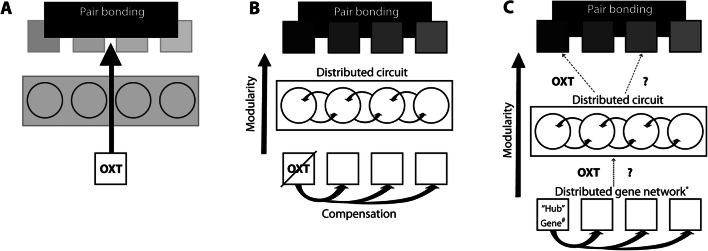Fig. 1.
Models of oxytocin function within circuits encoding pair bond behavior. A Common model based on historical studies suggesting oxytocin acts as a primary genetic mediator of pair bonding behavior, whether through its action on local circuitry in select brain regions or on nodes integrated within a distributed circuitry. This is also in contrast to its potential modular action on specific subcomponents of pair bonding behavior, where other genes or gene networks may independently regulate distinct components of pair bonding (both shown in gray). B Model depicting three hypotheses: one in which the loss of Oxt/Oxtr is compensated for by other genes, another proposing a modular structure of genetic and neural circuit architecture, and finally, the potential for distributed but coordinated circuitry mediating distinct domains of pair bonding behavior (gray squares). C A third model depicting the hypotheses in B, but indicating a neural structure that is not specified by Oxt/Oxtr, but by either another regulatory “hub” gene (#) or a distributed gene network (*). In this model, Oxt signaling and/or other molecular mediators may act to control aspects of gene or circuit function (dashed lines) without being necessary for development of the underlying circuitry for pair bond behaviors. Parallel or compensatory processes may play a role in mediating specific behavioral outputs at any of the genetic or neural levels of regulation depicted

